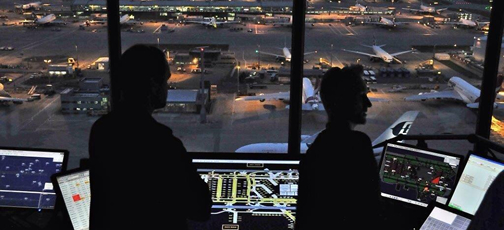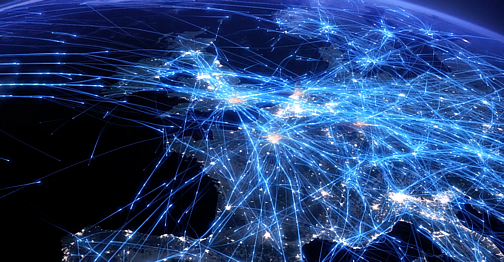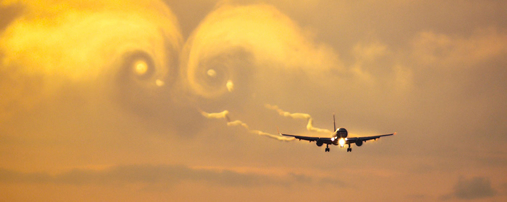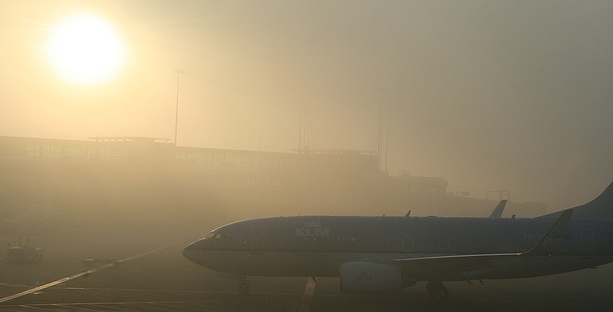Can you decipher these air traffic control phrases?
4 April 2014English is the international language of the air, although a few minutes spent listening to an air traffic controller and you’d be forgiven for not realising it!
Over the decades aviation has collected a unique blend of specialist terminology and a dizzying array of acronyms.
But, it is a language that pilots and controllers all over the world will recognise, with the standardisation helping to ensure efficiency and above all, safety.
However, to the uninitiated it can seem as impenetrable as any foreign tongue. So we wanted to see how good you were at deciphering five phrases from Heathrow controller, Ady Dolan.
Leave a comment with what you think the ‘translation’ is to these common air instructions, not forgetting the bonus round at the bottom.
And no cheating!
1. “After departure, climb straight ahead London 2 DME”
2. “Cleared to New York Kennedy, Compton 3 Foxtrot departure, Squawk 6244, QNH 998 Hectopascals”
3. “Turn right on Bravo, Link 21 join Alpha, hold at MORRA”
4. “Follow the greens, Stand 544”
5. “Speedbird 472, LOC/DME approach, Runway 27 Left”
Bonus round
Most aircraft use the airline name as the start of its callsign, e.g. Air France 4421, Lufthansa 371, United 232. But some, like BA with Speedbird, have unusual alternatives.
Can you identify these airlines just from their callsigns?
Shamrock
Springbok
Cactus
Eurotrans
Dynasty
Bealine
Cedarjet
Clipper
Just add a comment with your answers and we’ll reveal the truth later today.
Comments
Please respect our commenting policy and guidelines when posting on this website.





04.04.2014
11:57
graham haywood
Whilst I might be able to make an educated guess at some of the answers, I really wanted to comment that I think this is an excellent use of this space and would welcome more of it. Well done Paul & Andy.
04.04.2014
13:00
David
1. Once airbourne climb straight ahead until 2nm from LON VOR,
2. This is a departure clearance (NOT a takeoff clearance). The aircraft is cleared to JFK via the Compton 3 F SID. Their squawk code to put into the transponder is 6244 to identify them on radar and the air pressure at MSL is 998 hPa. The word hectopascal is only said when the QNH/QFE is lower than 1000.
3. These are taxi instructions. Turn right onto Bravo taxiway and use Link 21 to get to Alpha taxiway and then hold at holding point MORRA.
4. Green taxiway lights highlight the route that ATC have chosen to the aircrafts stand which in this case is 544. The aircraft is being instructed to follow these green taxiway centreline lights.
5. This BA aircraft is using the localiser DME to runway 27L. This will give lateral guidance to the aircraft but the pilots will have to use their distance measuring equipment to work out their descent rate and the altitude they will need to be at at certain distances from the airport which is printed on their approach charts.
Bonus Round.
1. Aer Lingus,
2. South African,
3. US Airways,
4. Don’t Know,
5. Don’t Know,
6. Brussels Airlines,
7. Don’t Know,
8. Don’t Know.
04.04.2014
13:11
Lily
1. After take off climb on runway heading to 2 nautical miles from the London distance measuring equipment.
2. Cleared on take off to follow standard “Compton3F” departure route. Destination is Kennedy New York. Squawk is transponder code to be entered and QNH is the pressure setting.
3. Is taxiing instructions while at the aerodrome. MORRA is a reporting point on the ground. Bravo and Alpha are taxiways. Link21 is probably a crossing.
4. No doubt at heathrow where planes follow green lights on the taxiways to their passenger gate.
5. Instructions from approach controller for a Localiser/distance measuring equipment approach into heathrow. Sort of like a talk down.
I’ll let someone else do the bonus round 😉
04.04.2014
13:15
Bernie Brooks
as a former private pilot I understood most of them , but some were for IFR pilots which I was not
04.04.2014
13:30
Richard Jones
Is it ok to listen in to ATC IN THE UK?
04.04.2014
13:32
Andy Russell
Go on, I’ll have a go:
1 – After tako off, fly in a straight line for 2 miles
2 – Your ATC clearance is to follow the standard instrument departure route, transponder code 6244 and the atmospheric pressure above mean sea level is 998 hPa (or millibars)
3 – Taxi instructions: follow taxiways to holding point
4 – follow the green taxiway lights to your stand number
5 – British Airways 472, standard instrument landing system arrival on runway 27 left
Airlines are: Aer Lingus, South African Airways, US Airways, European Air Transport (DHL), China Airlines, Brussels Airlines, Middle East Airlines, Pan Am.
04.04.2014
13:35
Alex
There’s no point rewriting what david said because I agree with his answers! Missing callsigns:
4. A franchised part of DHL but used in most European stuff as opposed to “World Express”
5. Air China
7. Middle Eastern Airlines (Logo is cedar tree)
8. Pan Am but not sure if its being reused by someone now…
04.04.2014
13:54
Bart Notenboom
1. Departure instructions, after takeoff, climb straight ahead to 2NM from the London VOR.
2. Departure clearance to New York JFK, which is allowed via the Compton 3 Foxtrot departure route, whilst squawking 6244. The air pressure is 998 hectopascals.
3. Taxi instructions, make a right turn on Bravo, use Link 21 to get to Alpha and then hold at MORRA.
4. Taxi instructions, follow the green taxi lights to stand 544.
5. Approach clearance, the British Airways flight 472 is going to approach runway 27L on the Localiser/DME approach.
Bonus round:
Shamrock: Aer Lingus
Springbok: South African Airways
Cactus: America West Airlines
Eurotrans: European Air Transport
Dynasty: China Airlines
Bealine: British European Airlines
Cedarjet: Middle East Airlines
Clipper: Pan American World Airways
04.04.2014
14:17
Anon
Bonus stabs only, and similarities with David’s restricted to where I agree with him. 😉
Shamrock – Aer Lingus
Springbok – South African
Cactus – Mexican?
Eurotrans – No seguro
Dynasty – No seguro
Bealine – No seguro
Cedarjet – Lebanon?
Clipper – No seguro
04.04.2014
15:04
Ted
Shamrock – Aer Lingus
Springbok – South African Airways
Cactus – US Airways
Eurotrans – European Air Transport (DHL Europe)
Dynasty – China Airlines
Bealine – Brussels Airlines
Cedarjet – Middle East Airlines
Clipper – Pan Am
04.04.2014
15:09
Charlie Baker
I think BEA’s callsign Bealine was retained by BA after the merger with BOAC and is now used for ground towing movements at LHR
04.04.2014
17:28
David Sullivan
1. After take off climb straight a head (runway heading) until two miles from LON VOR.
2. This is a clearance to New York on the Compton 3 foxtrot standard instrument departure. Put 6244 into your transponder and have 889ha set on the altimeter as QNH.
3. Taxi instructions to turn right onto bravo taxiway. Continue via link 1 to alpha taxiway and stop at holing point MORRA.
4. Follow the green lights on the taxiway and they will bring you you your parking at stand 544.
5. British airways plane given instructions to do a localiser/distance measuring equipment approach to runway 27 left.
Bonus round
1. Aer lingus
2. South African
3. Pass
4. Pass
5. Pass
6. Pass
7. Pass
8. Pan am
04.04.2014
18:23
Raul Carboni
Agrre with Charlie Baker about the “B Line” call sign
05.04.2014
08:31
Shamrock
Great to see everone knows my airline’s call sign! 😉
07.04.2014
09:52
Paul Beauchamp
Senior Communications Manager, Brand PR & Marketing CommunicationsWe thought it was about time to put you out of your misery…
Thanks to everyone who took the time to comment – it was fun to read everyone’s submissions. If there are any other similar quizes you’d like us to run in the future, we’re always open to ideas.
Paul
1. “After departure, climb straight ahead London 2 DME”
This means, after take off, climb straight ahead until you are 2 nautical miles from the ‘LONDON’ Distance Measuring Equipment beacon.
2. “Cleared to New York Kennedy, Compton 3 Foxtrot departure, Squawk 6244, QNH 998 Hectopascals”
This means that you are cleared to JFK airport, routing via the Compton 3F Standard Instrument Departure. Your transponder code is 6244, and the atmospheric pressure at sea level is 998 Hectopascals (or millibars).
3. “Turn right on Bravo, Link 21 join Alpha, hold at MORRA”
This is a taxi instruction for an outbound aircraft. The aircraft must route along taxiway Bravo, then change to taxiway Alpha at Link 21. It must stop at when it gets to MORRA, which is a runway holding point.
4. “Follow the greens, Stand 544”
This is used when the Airfield Ground Lighting system is switched on, either at night or in poor visibility. In this instance, an inbound aircraft is given green taxiway centreline lights, controlled from the Visual Control Room (Tower) to its parking stand.
5. “Speedbird 472, LOC/DME approach, Runway 27 Left”
This is a transmission by an inbound aircraft. Speedbird is the callsign used by British Airways, and the aircraft is flying the approach using the Localiser signal (to maintain lateral position on final approach), and the DME (Distance Measuring Equipment which tells him how close he is to the runway).
Bonus round
Shamrock – Aer Lingus
Springbok – South African Airways
Cactus – US Airways
Eurotrans – DHL
Dynasty – China Airlines
Bealine – Brussels Airlines
Cedarjet – Middle East Airlines
Clipper – Pan Am
09:52
Paul Beauchamp
Senior Communications Manager, Brand PR & Marketing Communications07.04.2014
18:48
Vic
Preuming on No 5, with a LOC/DME approach, that the Glidepath which provides glideslope guidance, is unserviceable on 27L otherwise it would be a normal ‘ILS Approach’?
09.04.2014
11:32
Ady Dolan
Air Traffic ControllerHi all,
Everyone in the tower has been very impressed with the quality of the entries, but the clear overall winner has to be David, although it was Andy Russell who was first to get all the callsigns right!
Congratulations to David and Andy and thanks to everyone for playing along – hope you enjoyed it.
Ady
11:32
Ady Dolan
Air Traffic Controller09.04.2014
17:08
Dan Nicholas
Isn’t number 5 meant to be “BAW427, CLEARED loc/dme approach runway 27L, QNH xxxx” ?
03.05.2014
00:00
Paul
I thought that Bealine was used by BA for ground movements at Heathrow, no?
16.03.2015
17:43
John
What does 5 East of a specific location mean?
24.07.2015
07:24
olly mac
Uv all forgot to tell ur pilots wot frequency to contact after takeoff.
02.11.2016
12:55
Andrew Page
I would like to know what is meant by statements from pilots and atc saying “with kilo” or “with alpha”, “heavy” or on atis “with Zulu you have”
09.09.2020
14:57
eat
all i know is cactus is us airways and maybe dynasty is an asian airline i forgot